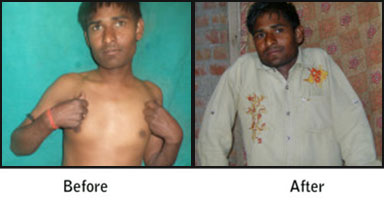Brachial Plexus Surgery India
Brachial plexus is group of nerves formed in the neck and give branches which form other nerves that control movements and sensation in upper limbs, along with shoulder, arm, forearm, and hand. Radial, Median, and Ulnar nerves originate in Brachial Plexus.
Various causes of brachial plexus injury are:
Majority of Paediatric and Adult Brachial Plexus Injuries are caused by trauma. Inciting events for these injuries may include:
- High-speed accidents, especially motorcycle accidents
- Blunt trauma
- Sharp stab or gunshot wounds
- Inflammatory process (brachial plexitis)
- Compression (like a growing tumor)
- Neuropathies
A Brachial Plexus injury occurring during birth is called as Obstetric Brachial Plexus Palsy.
What is Obstetric Brachial Plexus Palsy?
This is a type of Brachial Plexus Palsy occuring in less than 1% of the births & is commonly seen when there is difficulty in delivering the baby’s shoulder. In delivery, baby’s shoulder becomes impacted on the mother’s pubic bone causing brachial plexus to stretch and cause injury (shoulder dystocia). The chance for recovery depends on pattern, complexity & intensity of injury. Erb’s Palsy refers to an injury of upper brachial plexus nerves (C5,6,7) leading to loss of motion around the shoulder and ability to flex the elbow. Klumpke’s palsy refers to an injury of lower brachial plexus nerves (C8,T1) leading to loss of motion in hand.
Types of brachial plexus injuries seen are:
- Avulsion – this means nerve has been pulled out from spinal cord and chance of recovery are almost negligible.
- Rupture – this means nerve has been stretched and partially torn, but not at spinal cord level.
- Neurapraxia – this means nerve is gently stretched and/or compressed but still attached and has good prognosis for rapid recovery
- Axonotmesis – this means the axons (like copper filaments in electrical cable) are completely cut. The prognosis is moderate.
- Neurotmesis – this means nerve is completely divided. Chances of recovery are very poor.
- Neuroma – this refers to a type of tumor that grows from a drag of divided axons (nerve endings), which fail to regenerate. The prognosis will depend on what percentage of axons do regenerate.
Symptoms of a brachial plexus injury
BPI may result in some of the following symptoms:
- Pain
- Loss of sensation
- Muscle weakness
- Paralysis of some or all of the muscles of the shoulder and upper limb
Some patients may experience isolation pain (a burning, crushing type of pain) in the distribution of the injured nerves.
Diagnosis of brachial plexus injury
Due to the complex spectrum of brachial plexus injuries, a detailed and comprehensive understanding of the precise nature of injury in every patient is required for proper management.
Multiple modalities are utilized to diagnose a brachial plexus injury including:
- History taking and clinical examination
- Electrodiagnostic studies (EMG, NCV, SNAP, SSEP)
- Imaging studies (CT, MRI)
Some of these evaluations may need to be repeated on regular basis to trace progression of recovery.
Mostly used in combination, these modalities provide valuable insights into the nerves of the brachial plexus which have been injured providing information about severity of the injury and prognosis of it’s outcome.
Treatment for a brachial plexus injury
Due to the broad spectrum of brachial plexus injuries, it is difficult to calculation the speed of spontaneous recovery. The potential for spontaneous recovery depends on the type and severity of injury. Therefore, prognosis must be assessed for every patient individually based on the type and severity of their injury, and the progression of any spontaneous recovery that may be occurring.
Nonsurgical treatment choices for brachial plexus injuries
Depending on the degree of severity, some nerve injuries are ready to heal on their own. If this is not a viable choice for a particular patient, a surgical option may be recommended by the physician. Physical rehabilitation medical is always part of the recovery procedure for a brachial plexus injury.
Surgical treatment choices for brachial plexus injuries
The degree of functional problems and potential for subsequent recovery depends on the mechanism, type, and time since injury. The most important judgment Dr Satya Saraswast your Brachial Plexus Surgeon at Saraswat Hospital will make is to determine if and when surgical intervention should occur.
Various Treatments for Brachial Plexus are:
Neurolysis- Various adhesions on the nerve are released, thus making the current flow again through the nerves.
Nerve Graft – The damaged part of Brachial Plexus is removed and replaced with nerve grafts harvested from other parts of the body.
Nerve Transfers- When the nerve root is avulsed from spinal cord, we isolate and use nerve which is less important, that is still attached to the spinal cord and connect it to the part of the nerve which is avulsed from the spinal cord.
Conduction of brain current grows slowly through nerve, about an inch (2.5 centimeters) a month, so takes several months for the final results of surgery.
Muscle & Tendon Transfers: It is a procedure in which Brachial Plexus surgeon removes less important muscle or tendon from one part of body, transfers it to arm, and reconnects nerves and blood vessels supplying the muscle.











